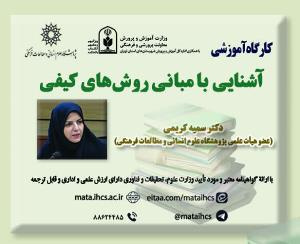بررسی نقش میانجی تنظیم شناختی هیجان در رابطه سبک های دلبستگی و سواد عاطفی با گرایش به روابط فرازناشویی (مقاله پژوهشی دانشگاه آزاد)
درجه علمی: علمی-پژوهشی (دانشگاه آزاد)
آرشیو
چکیده
هدف: گرایش به روابط فرازناشویی از بحرانی ترین مسائل زوج ها محسوب می گردد و بنظر می رسد روابط زناشویی بر پایه دلبستگی شکل می گیرد و هیجان و نحوه تنظیم آن بخش جدایی ناپذیر آن است. هدف پژوهش بررسی نقش میانجی تنظیم شناختی هیجان در رابطه سبک های دلبستگی و سواد عاطفی با گرایش به روابط فرازناشویی بود. روش: روش پژوهش از نوع همبستگی بود. جامعه آماری شامل جمعیت تقریبا 10 هزار نفری زنان با تجربه خیانت به شوهران بود که به دادگاه خانواده و مراکز مشاوره و خدمات روان شناختی شهر تهران در سال 1398 مراجعه کرده بودند. با توجه به جدول کرجسی و مورگان تعداد 373 نفر به روش نمونه گیری خوشه ای انتخاب شدند. ابزارهای پژوهش عبارت بودند از؛ مقیاس نگرش به روابط فرازناشویی واتلی (2008)، پرسشنامه تنظیم شناختی هیجان گارنفسکی و همکاران (2001)، خرده مقیاس سواد عاطفی از مقیاس کارکردهای روان شناختی خانواده ایرانی کیمیایی و همکاران (2012) و پرسشنامه دلبستگی بزرگسالان هازان و شاور (1987). تحلیل داده ها با معادلات ساختاری و نرم افزار SPSS-25 و Amos-24 انجام گرفت. یافته ها: مدل پژوهش از برازش مطلوبی برخوردار بود. اثر مستقیم سبک های دلبستگی بر گرایش به روابط فرازناسویی معنادار بود (01/0>P). اثر غیرمستقیم سبک های دلبستگی و سواد عاطفی با میانجی گری تنظیم هیجان منفی و اثر غیرمستقیم دلبستگی اجتنابی با میانجی گری تنظیم هیجان مثبت بر گرایش به روابط فرازناشویی معنادار بود (05/0>P). نتیجه گیری: افزایش تنظیم شناختی هیجان مبتنی بر دلبستگی و سواد عاطفی، می تواند راهی برای کاهش گرایش به روابط فرازناشویی باشد.Investigating the Mediating Role of Cognitive Emotion Regulation in the Relationship between Attachment Styles and Emotional Literacy with a Tendency to Extramarital Relationships
Purpose: The tendency to extramarital relationships is most critical issues for couples and it seems that marital relationships are formed based on attachment and emotion and regulate it is integral part of this relationship. The aim of this study was to investigate the mediating role of cognitive emotion regulation in the relationship between attachment styles and emotional literacy with a tendency to extramarital relationships. Methodology: The research method was correlational. The statistical population included a population of approximately 10,000 women with experience of infidelity of husbands who in 2019 referred to the family court and counseling centers and psychological services in Tehran. According to Morgan and krejcie table, 373 people were selected by cluster sampling. The research tools were; attitudes toward infidelity scale of Whatley (2008), Cognitive Emotion Regulation Questionnaire of Garnfsky et al (2001), Emotional literacy subscale from the scale of psychological functions of Iranian family of Kimiaei et al. (2012) and Adult Attachment Questionnaire of Hazan and Shawar (1987). Data analysis was performed using structural equations and SPSS-25 and Amos-24 software. Findings: The research model had a good fit. The direct effect of attachment styles was significant on the tendency to extrasensory relationships (P<0.01). Was significant indirect effect of attachment styles and emotional literacy mediated by negative emotion regulation and the indirect effect of avoidant attachment mediated by positive emotion regulation on the tendency to extramarital relationships (P<0.05). Conclusion: Increasing cognitive emotion regulation based on attachment and emotional literacy can be way to reduce tendency to extramarital relationships.







